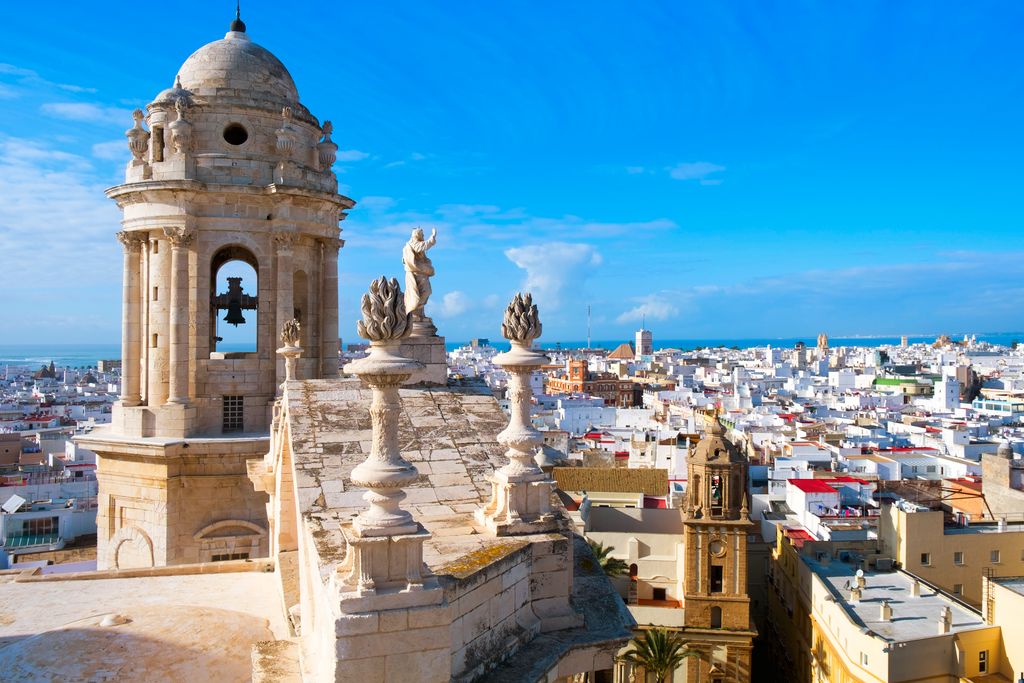I came to Spain late – my loss. I came to Andalucia even later and seek to remedy that deficiency by returning each winter to escape the grey London skies. Seville and Malaga, Granada and Cordoba are well known to many. May I make a plea for Cádiz?
The absence of an international airport has preserved it from the worst touristic excesses, yet it is an easy train journey from Seville. Once an island, Cádiz is approached across miles of salt flats, lending an air of mystery to this port city. The waves of the Atlantic beat down on one side of the isthmus, the other is gently lapped by the waters of the bay.
Cádiz boasts little of the spectacular; that is part of its charm. The old city constitutes a homogeneous whole: endless narrow 18th-century streets, largely pedestrianised, replete with wonderful wrought iron balconies and lanterns. Cuisine alone is a reason to visit. Superlative seafood, especially the red tuna, can be inspected in advance in the covered market, rated as one of the world's best by Rick Stein.
It isn't just the recent hordes of alcohol-fuelled youth on the Costa del Sol who have given the Brits a bad name in Andalucia. We have been achieving this rather successfully for centuries. Francis Drake famously "singed the King of Spain's beard" in 1587 when he attacked Cádiz, where the Armada was being assembled. Numerous vessels were sunk and captured, humiliating the mighty Spanish Empire. We were back come 1596, when the Earl of Essex, Walter Raleigh and others captured and burned the city. The Spanish themselves destroyed the treasure fleet from the Americas rather than allow it to fall into the hands of the English.
These raids had consequences, both secular and sacred. The respect the English showed the inhabitants of Cádiz did not extend towards their homes and churches. The image of the Madonna was dragged from the cathedral and desecrated in the market square. English Protestant swords mutilated the Virgin and Child, but God, of course, can bring good from evil. The Spanish tenderly retrieved the statue; initially venerated in a private chapel in Madrid, the Royal English Seminary in Valladolid successfully petitioned in 1600 to give her a home in reparation for the impieties of their compatriots. La Vulnerata has been venerated by English seminarians for three centuries and continues to occupy pride of place in their chapel to this day.
The raids of the English account in part for Cádiz's architectural homogeneity. The city had to be rebuilt; little remains of its medieval predecessor. The cathedral of Santa Cruz was among the buildings burned; the current structure begun in the 18th century was completed in the 19th, with baroque giving way to the classical. It is monumental, rather than mysterious.
The cathedral crypt contains the tomb of the composer Manuel de Falla, who was born in Cádiz in 1876 and died in Argentina in 1946. Much of his work was inspired by Andalucian folk music and that of the Church. Next to Falla's tomb lies the poet and playwright José María Péman (1897 - 1981), whose works reflect his deep Catholic faith. A rare literary supporter of Franco, he was later created a Knight of the Order of the Golden Fleece.
Among the loot carried off by those 16th-century raiders were 3,000 casks of sherry, the beginning of the English love affair with this Spanish wine. We ventured out to Jerez de la Frontera, the sherry capital, for a tour and tasting at the Valdespino bodega. There may have been some misunderstanding, given that our introduction had come through a Master of Wine. We felt it rude, however, to disabuse our hosts by revealing that we were not influential buyers in the wine trade and gratefully accepted the 90-year-old samples proffered.
Savouring the elegantly dry fino and the Pedro Ximénez reminiscent of dates, raisins and Christmas pudding, we were able to lay to rest definitively the ghost of grandmother's bottle of Harveys Bristol Cream. Try as I might, I was unable to discover a Catholic connection for the sherry industry: no Mass of the harvest nor blessing of the pressing. The last altar wine had been produced two decades earlier. The best I could manage was the photo in the bar of the local bishop looking longingly at some of the 25,000 casks stored here.
The Faith is vibrant in Cádiz, however. Though there are few prominent church towers and domes on the skyline, at street level one realises the number of parish churches and confraternity chapels tucked between the confectioners, bars and restaurants.
Each evening, Mass is celebrated in those churches and chapels. Confessions are heard and the Rosary prayed – Our Lady of the Rosary is the patroness of the city. The candles rising up the reredos from floor to ceiling in the church of the Conversion of St Paul across the road from our apartment made your average Roman altar of repose appear decidedly puritanical.
Cádiz. It offers Catholicism, culture and cuisine. What's not to like?
<em>Photo: An aerial view from Cádiz Cathedral across the city toward the sea. (Credit: iStock by Getty.)</em>
<em>Fr Mark Vickers is parish priest of Holy Ghost and St Stephen, London W12</em>.
<strong><strong>This article appears in the July/August 2025 edition of the <em>Catholic Herald</em>. To subscribe to our thought-provoking magazine and have independent, high-calibre and counter-cultural Catholic journalism delivered to your door anywhere in the world click <a href="https://thecatholicherald.com/subscribe/"><mark style="background-color:rgba(0, 0, 0, 0)" class="has-inline-color has-vivid-cyan-blue-color">HERE</mark></a></strong></strong>.



